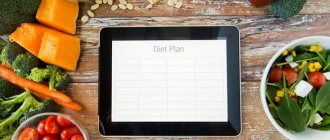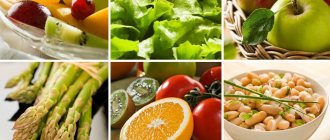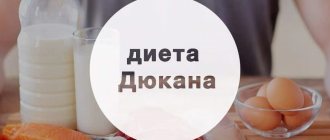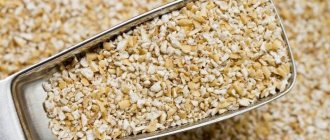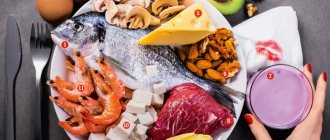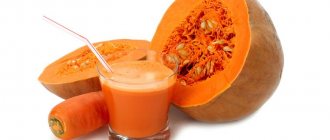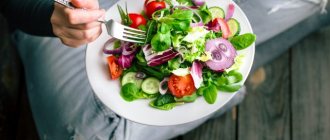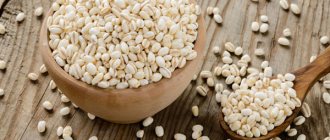- Basic principles
- Effect on the body
- Contraindications
- Sample menu
- Recipes
- results
Losing extra pounds, especially if there are a lot of them, is not easy.
However, you shouldn’t despair: a unique protein-vegetable diet will allow you to do this in the shortest possible time. You can choose its duration yourself. A wide selection of permitted foods allows you not to starve during this entire time. What do you need to know about this technique for those who plan to lose weight using it?
Basic principles
As with any other diet, it is necessary to follow certain principles, without which the long-awaited weight loss will not occur.
Food
Since the diet requires 2 days of protein and 2 days of vegetables, the list of permitted foods automatically includes:
- Low-fat milk: granular cottage cheese, yogurt (without sugar), whey, kefir
- Tomato juice without salt.
- Protein products: boiled dietary meat, poultry (chicken, turkey without skin), fish, egg whites, seafood, mushrooms.
- Vegetables: asparagus, green peas, soybeans, lettuce, spinach, eggplant, zucchini, cucumbers, peppers, cabbage, celery, tomatoes.
- Recommended drinks include green or herbal teas.
- Honey (it will replace sugar).
- Nuts, seeds.
Vegetables can be eaten stewed, raw, baked, boiled. You can't fry anything. It is better to steam meat and fish, or, in extreme cases, stew or bake. There is a list of prohibited products. You can't eat:
- from vegetables and fruits - beets, carrots, potatoes, grapes, apricots, melon, bananas (they contain a lot of starch);
- cereal porridge;
- legumes;
- smoked meats;
- sausage;
- lard, fatty meat;
- oil;
- semi-finished products;
- sugar, salt;
- coffee, black tea.
The more closely you adhere to these two lists, the more impressive the result will be.
Useful tips
- Eat no more than 300 grams of food at a time.
- Drink about 1.5 liters (at least) of clean water during the day.
- There are fruits and vegetables with peel.
- Remove the skin from the bird.
- You cannot break the alternation: take either two days of protein and two days of vegetables, or change the mono-diet every day, and maintain this line to the end.
- Do light sports: cycling, swimming, aerobics, shaping, etc.
- Walk outdoors as much as possible.
Quitting the diet
During weight loss, the body gets used to alternating protein day/vegetable day - accordingly, it needs to be properly prepared for leaving the diet. The transition to a normal diet should be carried out gradually:
- the next day after finishing the diet, you can begin to lightly add salt to foods;
- It is allowed to gradually include oil in the diet: add it to salads, for example;
- on day 2 you can eat 2 jacket potatoes with beet salad;
- you can drink 50 ml of coffee with milk in the morning, you can switch to black coffee only after a week;
- For 4-5 days, stick to lean varieties of meat and fish - but they can be lightly fried in a small amount of oil.
After protein and vegetable weight loss, you can fully return to your usual diet only after a week. In this case, portions should be increased gradually. It is better to eat more often, but little by little. This will help avoid the return of the hated kilograms. Their loss, by the way, will depend on the duration of the diet.
Duration
The classic protein-vegetable diet scheme is designed for 18 days, although you can find menu options for 7, 14, 20 and 21 days. Nutritionists advise adhering to the following rotation (duration 21 days):
- Fasting days: 1-2, 7-8, 13-14, 19-20. This is how you can start and finish a weekly protein-vegetable diet - keep this in mind when creating a menu for 7 days.
- Protein days: 3–4, 9–10, 15–16, 21st.
- Vegetable days: 5–6, 11–12, 17–18.
You can choose a different scheme: alternating protein, vegetable and fasting days after 1, and not after 2 (then it’s better to create a menu for the week). The effectiveness of losing weight will not suffer as a result. After all, the effect of such a unique method of nutrition on the body will not change.
Nutrition rules
Basic principles of the diet:
- You need to eat lean meat and any vegetables every day;
- number of meals - 4-5 times a day;
- sugar and salt are completely excluded from the diet;
- Do not eat food 2 hours before bedtime;
- if you have a strong feeling of hunger in the evening, you need to eat a small amount of vegetables or drink a glass of kefir;
- in between meals, drink as much mineral still water as possible;
- food is steamed, boiled, stewed and baked;
- every day you need to drink 1.5–2 liters of water;
- you need to perform feasible physical exercises.
This diet is low in calories and rich in vitamins, minerals and nutrients. Therefore, the body does not experience stress and does not begin to store energy in the form of fat deposits.
The rate of water consumption depends on the age and weight of the person
Effect on the body
The basis of a protein-vegetable diet is the separate consumption of proteins and carbohydrates. This allows you to alternate protein and vegetable days: either 2 after 2, or 1 after 1. During the entire period of weight loss, the following processes will actively occur in the body:
- simple carbohydrates are not included in a protein-vegetable diet, as they are quickly broken down, creating excess energy, which leads to fat deposits;
- the body should consume only complex carbohydrates: they slowly break down and gradually release energy to the body: all of it is actively used and not stored in reserve;
- the diet involves reducing the diet and the number of servings, so the body will feel a lack of energy, replenishing it from its own fat deposits in problem areas;
- there will be enough protein so that the muscles and internal organs do not become exhausted;
- It will also help get rid of subcutaneous fat.
On the one hand, fat deposits are used by the body itself as a source of energy, on the other hand, thanks to proteins, depletion does not occur. That is, as a result, you lose those hated kilograms, while acquiring sculpted, beautiful body contours. The main thing is that a protein-vegetable diet does not harm your health. This is possible if contraindications are not observed.
Reviews
Veronica, 29 years old, Moscow: “I gained a lot of weight after the birth of my child, so after finishing breastfeeding I decided to go on a diet. I tried many different methods for losing weight, and the most successful was the one that was represented by proteins and vegetables. I followed it for a month, which allowed me to get rid of 6 kg. I consider this a good result, because other diets did not help at all. 3 months have passed, and the weight remains at the required level. I liked this food system because I didn’t have to starve, and the diet contains many dishes.”
Svetlana, 31 years old, Kaliningrad: “I have been overweight since childhood, and during pregnancy I gained especially much weight. I tried many different diets, but they were all ineffective. One day my cousin recommended a protein-vegetable diet. I followed it for 3 weeks. During this time I was able to lose 7 kg. Not only proper nutrition helped with this, but also regular visits to the pool. The menu for the week was made by myself from protein products and vegetables. I want to repeat it again in 3-4 months.”
Ekaterina, 24 years old, Yaroslavl: “During the preparations for my own wedding, I discovered that I had gained several kilograms and decided to urgently get rid of them. I didn’t follow any diets before, but was actively involved in sports. And in this case, physical activity alone is not enough. In 2 weeks on proteins and vegetables I was able to lose 6 kg. I’m extremely pleased with the result and the wedding photos.”
Marina, 35 years old, St. Petersburg: “I decided to go on a diet in the spring to prepare for the upcoming beach season. I resorted to a nutrition system that includes the consumption of vegetables and protein products. I tolerated it well, prepared various dishes (soups, salads) and drank a lot of water. The only downside is that towards the end of the diet my head began to hurt. As a result, in 3 weeks I lost 11 kg and am extremely pleased with the result. I want to repeat it in a few months.”
Contraindications
Any protein-vegetable diets (there may be several variations) do not provide the body with carbohydrates and fats. And if there are certain health problems, exacerbations of existing diseases and a deterioration in general condition may ultimately occur.
Contraindications for this method of losing weight are:
- Diseases of the gastrointestinal tract, kidneys, cardiovascular system, liver.
- Pregnancy.
- Lactation.
In order not to harm yourself, you should not go on a protein-vegetable diet if there are contraindications.
Indications for use
A diet that involves drinking for 1 day at once can hardly be called a universal method. This is a quick weight loss system that is not suitable for everyone and has a number of restrictions on its implementation.
Suitable for:
- a good option for those who have already practiced fasting days and can also easily tolerate a low-calorie menu;
- if obesity is a consequence of an unbalanced diet, if you are emotionally dependent on tasty food, it is better to look for other options for losing weight;
- you can choose for people with health indicators that correspond to the norm; in case of chronic disorders of the functioning of systems and organs, a diet with drinking, vegetable, drinking, fruit, protein days can lead to a deterioration in well-being and exacerbation of diseases;
- An excellent way to test willpower for people with a philosophical attitude to life, who can easily endure restrictions and discover new opportunities for self-improvement.
It is important to choose the right time for innovation. A daily diet, the first day drinking, and the subsequent fruit and protein, requires a stable psycho-emotional state. Vacation is considered the best time; you can make changes to your diet without being distracted by external factors.
Contraindications:
- pregnancy, lactation;
- psychical deviations;
- hypertension;
- pathologies of the liver, kidneys;
- diabetes;
- autoimmune diseases;
- age restrictions, under 18, over 60 years old.
Sample menu
We present to your attention a menu for 21 days as part of a protein-vegetable diet.
Fasting days menu
- Breakfast: 20 grams of bread with bran.
- Drink 200 ml per liter of kefir during the day.
- Before bed - a glass of unsalted tomato juice.
Protein days menu
3–4 days
- The next morning: green tea with milk, 5 ml of honey, rye bread.
- Lunch: fish broth, boiled chicken breast.
- For an afternoon snack: a little honey.
- For dinner: cheese, boiled eggs, beef, kefir.
9–10 days
- The next morning: herbal tea, rye bread, egg.
- Lunch: mushroom broth, stewed vegetables.
- For an afternoon snack: rosehip decoction with honey.
- For dinner: cheese, kefir, egg, rye bread.
15–16 days
- The next morning: green tea, omelette.
- Lunch: turkey.
- For afternoon snack: kefir, pomelo.
- For dinner: chicken breast, vegetable juice.
21 day
- The next morning: herbal tea, whole grain bread, egg.
- Lunch: meat broth, chicken cutlets.
- Afternoon snack: kefir, apple.
- For dinner: cottage cheese, boiled meat.
Vegetable days menu
5–6 days
- Breakfast: apple, orange.
- In the afternoon: vegetable soup and salad.
- Snack: pomelo, green tea.
- In the evening: stewed eggplants, vegetable juice.
11–12 days
- Breakfast: pepper and tomato salad, green tea, whole grain bread.
- Afternoon: fish and rice.
- Snack: kiwi, kefir.
- In the evening: boiled asparagus, vegetable juice.
17–18 days
- Breakfast: green tea, apple.
- In the afternoon: stewed vegetables, vinaigrette.
- Snack: vegetable casserole, celery juice;
- In the evening: green tea, vegetable stew.
This 21-day menu can be used for protein-vegetable diets of varying lengths: for a week, for 14 or 18 days. And at the same time, you will have to think about preparing dishes that would fit into this weight loss technique.
Second courses
The combination of protein products with complex carbohydrates and vegetable side dishes leaves room for the imagination of a losing weight cook. Changing the texture and presentation of boring chicken breast or another source of protein is a tactical move to ease the psychological perception of a protein diet.
Chicken fillet in kefir
Recipe No. 9
Cooking method:
- Wash the chicken fillet, pat dry on a paper towel, cut into small cubes or long strips.
- Finely chop the greens and add to the meat with salt, pepper and spices.
- Mix kefir with water, pour over fillet. Cover with a lid and place in the refrigerator for 2.5 - 3 hours.
- Heat a non-stick frying pan and place the meat in the pan without adding oil. Fry over high heat for 1 minute on each side. Next, reduce the heat, cover with a lid and simmer until done.
Ingredients: - chicken fillet - 350 g; - kefir 1% - 120 ml; – water – 80 ml; - parsley or dill - 1 bunch; - salt, pepper, spices - to taste.
Cod baked in the oven with vegetables
Recipe No. 10
Method of preparation:
- Wash the zucchini and remove the skin. Chop all vegetables into small cubes.
- Grate the cheese on a coarse grater, chop the herbs.
- Cut the fillet into small pieces.
- Fry the zucchini in a non-stick frying pan without adding oil for 2 minutes. Then add broccoli, cauliflower, salt and pepper. Stir and fry for another 3-5 minutes.
- Grease a baking dish with a drop of olive oil. Add half of the vegetable mixture, then evenly add the fish, adding salt. The next layer is half a portion of grated cheese and again vegetables. The last layer is a mixture of cheese and herbs.
- Place in an oven preheated to 200 degrees for 15 minutes.
Ingredients: - cod fillet - 300 g; — broccoli – 100 g; — zucchini – 300 g; — cauliflower – 100 g; — hard cheese – 50 g; — dill – 1 bunch; - salt, pepper, spices - to taste; - olive oil - for preparing the mold.
Chicken fillet rolls with avocado
Recipe No. 11
Method of preparation:
- Peel the onion and garlic. Rinse vegetables and herbs thoroughly and dry.
- Pour boiling water over the tomato and remove the skin. Cut into small cubes.
- Cut the soft avocado lengthwise and remove the pit. Scoop out the pulp with a spoon and puree with a fork.
- Cut the onion into small cubes. Chop garlic and herbs.
- Combine vegetables and herbs, add lime juice, salt and pepper to taste. Mix.
- Rinse the chicken fillet and dry. Cut the meat lengthwise into 2 parts, without cutting all the way through, to create a large steak. Lightly beat the fillet, place in a bowl, pour in soy sauce, and let sit for 15 minutes.
- Place the fillet on a flat surface and place half of the filling on one edge, roll the fillet into a roll. Do the same procedure with the second part of the meat.
- Place the rolls in a small baking dish, greased with olive oil, pour over the remaining soy sauce, and sprinkle with pepper.
- Place in an oven preheated to 180 degrees for 40-45 minutes.
Ingredients: - chicken fillet - 600 g; — avocado – 1 pc.; — lime – ½ piece; — tomato – 1 pc.; - garlic - 2 cloves; — onion – 1 pc.; – fresh basil – 2 sprigs; - soy sauce - 2 tbsp. l.; - salt, pepper - to taste.
Squid roll
Recipe No. 12
Method of preparation:
- Clean the squid from entrails and skin. Bring the water to a boil, lower the carcass into the pan for 10 seconds. If you keep it longer, the meat will become rubbery. Grind in a blender after cooling.
- Grate the cheese on a coarse grater and add to the squid. Add raw egg whites, salt and pepper to the mixture. Mix.
- Spread the mixture onto a silicone mat in an even layer. Place in an oven preheated to 180 degrees for 15 minutes.
- Filling: cut the boiled whites into cubes, chop the herbs, grate the cucumber on a coarse grater. Add yogurt, salt and stir.
- Place the filling on the warm crust and roll it into a roll. Cool before serving.
Ingredients: - squid carcass - 450 g; — hard cheese – 100 g; – cucumbers – 80 g; – egg white (raw) – 2 pcs.; – egg white (boiled) – 2 pcs.; — natural yogurt without additives 1.5% — 50 g; - greens, salt, pepper - to taste.
Fish cutlets with basil sauce
Recipe No. 13
Cooking method:
- Rinse the fillet and dry. Grind in a blender with onion, dill, egg and salt.
- With wet hands, form cutlets and fry in a non-stick frying pan on both sides under the lid.
- Sauce: mix yogurt, mustard, lemon juice, basil, salt.
Ingredients: - cod fillet - 350 g; — chicken egg – 1 pc.; — onion – 30 g; - strengthened - 1 bunch; — natural yoghurt 1.5% — 60 g; — mustard – ½ tsp; — dry basil – ½ tsp; – lemon juice – 1 tbsp; - salt - to taste.
Roast pork in soy sauce
Recipe No. 14
Method of preparation:
- Rinse the meat, dry and rub with garlic, lemon juice, salt, pepper, and chopped bay leaf.
- Place in a deep baking dish and place in an oven preheated to 180 degrees for 45 minutes.
- Every 10 minutes, baste the meat with the released juice.
- Cut the finished dish into pieces, place on a plate, pour over the remaining sauce from the baking dish and soy sauce.
***Fresh vegetable salad is suitable as a side dish.
Ingredients: - lean pork - 400 g; – soy sauce – 50 ml; – lemon juice – 2 tbsp; — bay leaf – 1 pc.; - garlic - 1 clove; - salt, pepper - to taste.
Diet homemade chicken sausages
Recipe No. 15
Method of preparation:
- Grind all ingredients with an immersion blender until smooth and creamy. Divide the mixture into 3 or more parts.
- Lay out the cling film in two layers, place the meat in the middle, wrap in the appropriate shape and secure with threads around the edges. Repeat the procedure with the remaining meat.
- Bring water to a boil in a deep saucepan and add sausages. Reduce heat to low, cover and simmer for 1 hour. The water should boil slightly, not bubbling.
- After an hour, release the sausages from the film, cool and roll in spices. Wrap in foil for at least 2 hours.
Ingredients: - chicken fillet - 350 g; — chicken thigh fillet – 350 g; – egg white – 4 pcs.; — milk 1.5% — 400 ml; - salt, spices - to taste.
Recipes
Creating a menu for every day is quite a painstaking job. We bring to your attention recipes for a protein-vegetable diet with detailed descriptions of how to prepare the dishes.
Protein dishes
Omelette recipe
Ingredients:
- 30 ml milk;
- 5 egg whites;
- greenery.
Preparation:
- Beat the whites until foamy.
- Pour milk into them in portions.
- Add chopped herbs.
- Mix.
- Lightly grease the pan with butter.
- Pour in the protein and milk mixture.
- Place in a preheated oven for 10 minutes.
Chicken cutlets recipe
Ingredients:
- 500 g chicken breast;
- 250 g beans;
- 150 grams of onion.
Preparation:
- Boil the beans.
- Rinse chicken breast with cold water.
- Pass all ingredients through a meat grinder.
- Form cutlets.
- Place on a baking sheet.
- Bake in a preheated oven for 20 minutes.
Vegetable dishes
Vinaigrette recipe
Ingredients:
- 1 cucumber;
- 200 g cabbage;
- 200 g green beans;
- 1 boiled beets;
- lemon juice.
Preparation:
- Chop all the vegetables into strips.
- Mix.
- It is allowed to season with undiluted lemon juice for taste.
Vegetable stew recipe
Ingredients:
- 250 g zucchini;
- 250 g cabbage;
- 250 grams of champignons;
- bulb;
- greenery.
Preparation:
- Cut food into cubes.
- Place in container. To fill with water.
- Put it in the oven to simmer for half an hour.
By including these dishes in the protein-vegetable diet menu, you will not disrupt your weight loss method, and you will not go hungry with such goodies. Just to achieve the desired results.
Advantages and disadvantages
This method of losing weight has the following advantages:
- quickly relieves hunger;
- saturates the body with essential amino acids;
- supports physical endurance and performance;
- increases immunity and mental activity;
- helps you lose weight by 10 kg in 20 days;
- well tolerated;
- no special skills are required to prepare dishes.
It also has disadvantages:
- many contraindications;
- not balanced;
- hypotension may develop due to lack of salt;
- increases the load on the liver and kidneys;
- provokes the development of headaches.
You need to exit the diet gradually, being careful.
results
What results should you expect if you want to lose weight with a protein-vegetable diet? This will depend on compliance with the recommendations, duration of the fast, lifestyle and desire to lose weight.
- Diet week - loss of 2-3 kg.
- 2 weeks - getting rid of 5-6 kg.
- 21 days - minus 10 kg.
Remember: a good protein-vegetable diet is one that does not cause discomfort, does not cause hunger, but at the same time helps to achieve the desired results in losing weight. Many women have already regained the slender contours of their bodies using this amazing technique. It's your turn.
How to get out of a diet correctly
If, at the end of the diet, you immediately start overeating on fatty and sugary foods, all your efforts will be in vain. Moreover, you may gain even more than you weighed before the diet. Therefore, the right exit is very important.
After a diet, you need to eat in small portions. The diet should be moderate. You can continue to build it on proteins and plant foods, which are useful not only for losing weight, but also for staying fit, but add complex carbohydrates.
A protein-vegetable diet is a good option for healthy weight loss. Both nutritionists and those who have tried it on themselves speak well of it. But, of course, remember that diet is only a temporary measure. And in order to never be overweight again, you should develop healthy and proper eating habits.
Flaws
The protein-vegetable food system has few disadvantages. At first glance, it may seem that the range of permitted products is too limited. But if you use your imagination and study forums on diets and proper nutrition, you will find that there are a lot of options to diversify the menu.
This diet can overload the kidneys and liver due to its high protein content.
If you do not follow the drinking regime, constipation may occur.
For people who are accustomed to eating salty, fried, fatty, sweet and starchy foods in large quantities, this diet can be very difficult physically and mentally. As a result, there may be breakdowns and disappointments.
Partially limited products
There are products that are allowed in minimal quantities. These include:
- tomatoes, which increase appetite;
- dairy products can be consumed selectively (except for butter, sour cream);
- vegetable oil is allowed in limited quantities;
- occasionally it is allowed to add honey to drinks;
- complex carbohydrates – buckwheat porridge, rice;
- cranberry juice without sugar, herbal tea, green tea, coffee;
- cabbage is allowed on certain days, due to increased flatulence.
Products high in protein are included in the list of permitted consumption
Rules
- For the diet to be effective, you need to take lean meat: chicken, turkey, beef, offal.
- You can buy any fish: river and sea, lean and fatty. Seafood is also suitable for this food system.
- Choose fermented milk products with minimal fat content.
- Do not use frying during the cooking process, give preference to boiled, baked, steamed and grilled products.
- All spices are allowed, but only natural ones.
- Greens can be used in unlimited quantities
- You need to drink at least 2-2.5 liters of plain clean water per day. Other drinks allowed include any type of tea, coffee in moderation, low-fat kefir, yogurt, milk, fruit compotes and dried fruits in moderation.
- It is allowed to use extra virgin olive oil for dressing salads.
- Alcohol is excluded.
- Sugar is prohibited; it can be replaced with organic sweeteners or a small amount of honey.
- Physical activity will help you lose weight.
- Do not eat before bed, ideally 3-4 hours before.
- Portions can be kept as usual.
- The use of vitamins, especially those containing fatty acids, is encouraged.
